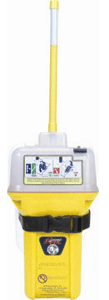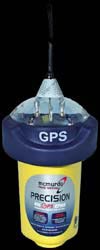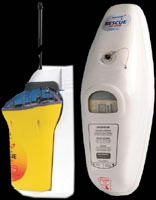- Home
- Safety
- EPIRBs, PLBs & Personal Trackers
- 406 MHz EPIRBs
406 MHz EPIRBs
406 MHz EPIRBs
Emergency Position Indicating Radio Beacons
 406 MHz EPIRBs take the "search" out of search-and-rescue! These high tech, 406 MHz Emergency Position Indicating Radio Beacons (EPIRBs) utilize the sophisticated satellite technology and a global emergency response and Search-and-Rescue network - a system trusted for nearly 20 years; that, through December of 2005 had provided assistance in rescuing 20,531 persons in 5,752 incidents worldwide.
406 MHz EPIRBs take the "search" out of search-and-rescue! These high tech, 406 MHz Emergency Position Indicating Radio Beacons (EPIRBs) utilize the sophisticated satellite technology and a global emergency response and Search-and-Rescue network - a system trusted for nearly 20 years; that, through December of 2005 had provided assistance in rescuing 20,531 persons in 5,752 incidents worldwide.
 What is a 406 MHz EPIRB ?
What is a 406 MHz EPIRB ?
A 406 MHz EPIRB is a battery-powered emergency transmitter which sends a coded 406 MHz radio signal when activated by a vessel or person in distress. The EPIRB's distress signal contains a Unique Identification Number (UIN) that identifies the registered owner. A network of satellites are deployed to receive signals transmitted by 406 MHz transmitting emergency devices comprising the COSPAS-SARSAT Satellite System developed bythe internationalcooperative of the United States, Canada, Russia and France that operated the global satellite monitoring system for 406MHz EPIRBs, PLBs and P-EPIRBs. A signal received by a GEOSAR (geostationary high earth orbiting satellite receiving a 406 MHz signal with GPS location data) or a LEOSAR (low earth orbiting satellite receiving 406 MHz signal only) satellite is then downloaded to a Ground Station Local User Terminal. of A transmitted signal from a 406 MHz emergency devise is considered to be a serious distress emergency and appropriate Search-and-Rescue (SAR) agencies are notified to respond. These devises also transmit on the 121.5 MHz frequency used by Search-and-Rescue personnel as a local homing frequency.
406 MHz EPIRB vs. 406 MHz Personal Locator Beacon:
The larger EPIRB is designed to be carried on a vessel; has a larger battery; is designed to transmit continuously for a minimum of 48 hours; and, may be deployed manually ("category II") or deployed automatically ("category I"). A 406 MHz Personal Locator Beacon is a small and compact devise designed to be carried by and on an individual. This devise has all of technology and capabilities of the larger EPIRB, with the exception of size and battery capacity / operating time. A 406 MHz Personal Locator Beacon is designed to transmit continuously for a minimum of 24 hours.
Commercial Fishing Requirements:
 All Commercial Fishing Vessels operating on the High Seas ( beyond the 3 mile territorial limit ) are required to have a registered 406 MHz EPIRB satisfying the following requirements:
All Commercial Fishing Vessels operating on the High Seas ( beyond the 3 mile territorial limit ) are required to have a registered 406 MHz EPIRB satisfying the following requirements:
Vessels less than 36 feet must carry a 406 MHz EPIRB - Category II
Vessels 36 feet or more must carry a 406 MHz EPIRB - Category I
The master of the vessel is responsible to insure that the 406 MHz EPIRB has been registered, with the current registration sticker affixed to the unit; has a fully charged battery, with valid expiration date; has been tested for proper operation upon installation onboard; and, is tested for proper operation at least once a month.
406 MHz EPIRB Categories:
A Category I, 406 MHz EPIRB will automatically deploy and activate when in contact with water. It is designed to float free at a depth of 1.5 to 4 meters ( 4.9 to 13.1 feet). The unit can be manually activated while in its bracket or be manually deployed and activated.
A Category II, 406 MHz EPIRB is manually deployed. A Category 2 unit will automatically activate when in contact with water and not in the bracket designed by the manufacturer's for its intended use (even if the manual switch is in the "off" position).
406 MHz EPIRB Classes:
Class 1 EPIRBs are rated for operation in extreme cold climates - to operate for a minimum of 48 hours at -40°C / -40°F.
Class 2 EPIRBs are rated for operation in more temperate climates - to operate for a minimum of 48 hours at -20°C / -4°F.
How a 406 MHz EPIRB works:
 Each 406 MHz EPIRB is programmed with its own 15-character Unique Identification Number (UIN) that uniquely identifies its owner and instantly provides emergency contact information to rescuers. When the 406 MHz EPIRB, without GPS location data transmission capability, is activated, its digital 406 MHz signal is transmitted to a constellation of 10 COSPAS-SARSAT satellites in polar orbits, each of which makes an orbital pass every 90 minutes. Using the Doppler shift technique, the satellites can determine a fix on the origin of the signal. Because of the satellite's sophisticated tracking capability, a Doppler position accuracy of 2.3 nautical mile is possible.
Each 406 MHz EPIRB is programmed with its own 15-character Unique Identification Number (UIN) that uniquely identifies its owner and instantly provides emergency contact information to rescuers. When the 406 MHz EPIRB, without GPS location data transmission capability, is activated, its digital 406 MHz signal is transmitted to a constellation of 10 COSPAS-SARSAT satellites in polar orbits, each of which makes an orbital pass every 90 minutes. Using the Doppler shift technique, the satellites can determine a fix on the origin of the signal. Because of the satellite's sophisticated tracking capability, a Doppler position accuracy of 2.3 nautical mile is possible.
The distress signal with its UIN and position is stored by the satellite. As the low-earth orbiting LEOSAR satellites must pass over a ground monitoring station, or Local User Terminal (LUT), to download data, it can take as long as 1 hour for the information to reach ground personnel. The LUT forwards the data to a Mission Control Center where personnel call the emergency contact numbers registered by the 406 MHz EPIRB owner / user to make verification and confirm background information, prior to launching a rescue operation through a local Rescue Coordination Center.
A 406 MHz EPIRB with GPS capabilities is even more accurate because it utilizes GPS-derived position information to transmit precise Lat/Lon coordinates. These 406 MHz signals with GPS data are received by a geostationary high earth orbiting GEOSAR satellite. This system reduces the time it takes to notify search-and-rescue personnel to as little as 2 - 15 minutes, and greatly increases the accuracy of the position information they receive to within .05 nautical miles or 100 meters.
Registering you 406 MHz EPIRB:
 When you purchase a 406 MHz EPIRB, you must fill out a registration form and forward it to the appropriate agency - in the U.S., it's the National Oceanic and Atmospheric Administration (NOAA). On the form, you provide the make, model, and 15-character unique identification number (UIN) of your 406 MHz EPIRB, your name, address, phone number, and primary and alternate 24-hour emergency contact phone numbers. You can also include travel / use plans, number of persons onboard, any significant medical information or other information that may assist rescuers in the event of an emergency.
When you purchase a 406 MHz EPIRB, you must fill out a registration form and forward it to the appropriate agency - in the U.S., it's the National Oceanic and Atmospheric Administration (NOAA). On the form, you provide the make, model, and 15-character unique identification number (UIN) of your 406 MHz EPIRB, your name, address, phone number, and primary and alternate 24-hour emergency contact phone numbers. You can also include travel / use plans, number of persons onboard, any significant medical information or other information that may assist rescuers in the event of an emergency.
This information is entered into a database accessible at the Mission Control Center, so that if your 406 MHz EPIRB is ever activated, your information will immediately pop up on a computer screen at the MCC. Personnel will then attempt to contact the registered owner / user of record and the designated emergency contacts to establish that your distress signal is genuine (and not a false-alarm), and to verify everything they can about the owner / user's intended travel / area of use plan, whereabouts and possible situation. This information will then be passed on to the appropriate search-and-rescue agency.
Residents of the United States may now register their 406 MHz EPIRB online, and may also access and amend their registration information and intended travel / area of use plan at any time. The site is http://www.beaconregistration.noaa.gov/. This NOAA website is only open to US citizens, US citizens living abroad, and alien residents currently living in the US with a valid US address. Once a 406 MHz EPIRB is registered the information is valid worldwide.
NOAA recommends registration of a 406 MHz EPIRB in the country of residence and / or country where the designated emergency contacts reside to avoid a potential language barrier problem.
It must be noted that all 406 MHz EPIRB must be electronically coded for the country in which the devise is to be registered. All 406 MHz EPIRBs and 406 MHz Personal Locator Beacons sold by OceanMedix.com LLC are default programmed and coded for registration in the United States with NOAA. Please contact OceanMedix.com LLC with regard to the availability of devises programmed and coded for registration in all other countries.
International Customers can check online at the the Cospas-Sarsat Satellite System website for contact information regarding the registration of 406 MHz EPIRBs in the country of residence worldwide. Once a 406 MHz EPIRB is registered the information is valid worldwide.
When to use a 406 MHz EPIRB:
 FCC rules state that a 406 MHz EPIRB is a satellite signaling devise of last resort, for use when all other means of self-rescue have been exhausted, where the situation is grave and imminent and the loss of life, limb, eyesight or valuable property will occur without assistance.
FCC rules state that a 406 MHz EPIRB is a satellite signaling devise of last resort, for use when all other means of self-rescue have been exhausted, where the situation is grave and imminent and the loss of life, limb, eyesight or valuable property will occur without assistance.
Because the consequences of a false distress signal are serious, it is recommended that you:
- Avoid activation except in a true emergency.
- Read all the instructions and know how your 406 MHz EPIRB works.
- Ensure your 406 MHz EPIRB is in good working order and the battery has a full charge.
- Make sure your 406 MHz EPIRB is properly registered and that all information is up-to-date.
Please Note : Due to restrictions imposed by the manufacturers, 406 MHz EPIRBs may not be returned for a refund once the box has been opened.
 Loading... Please wait...
Loading... Please wait...
